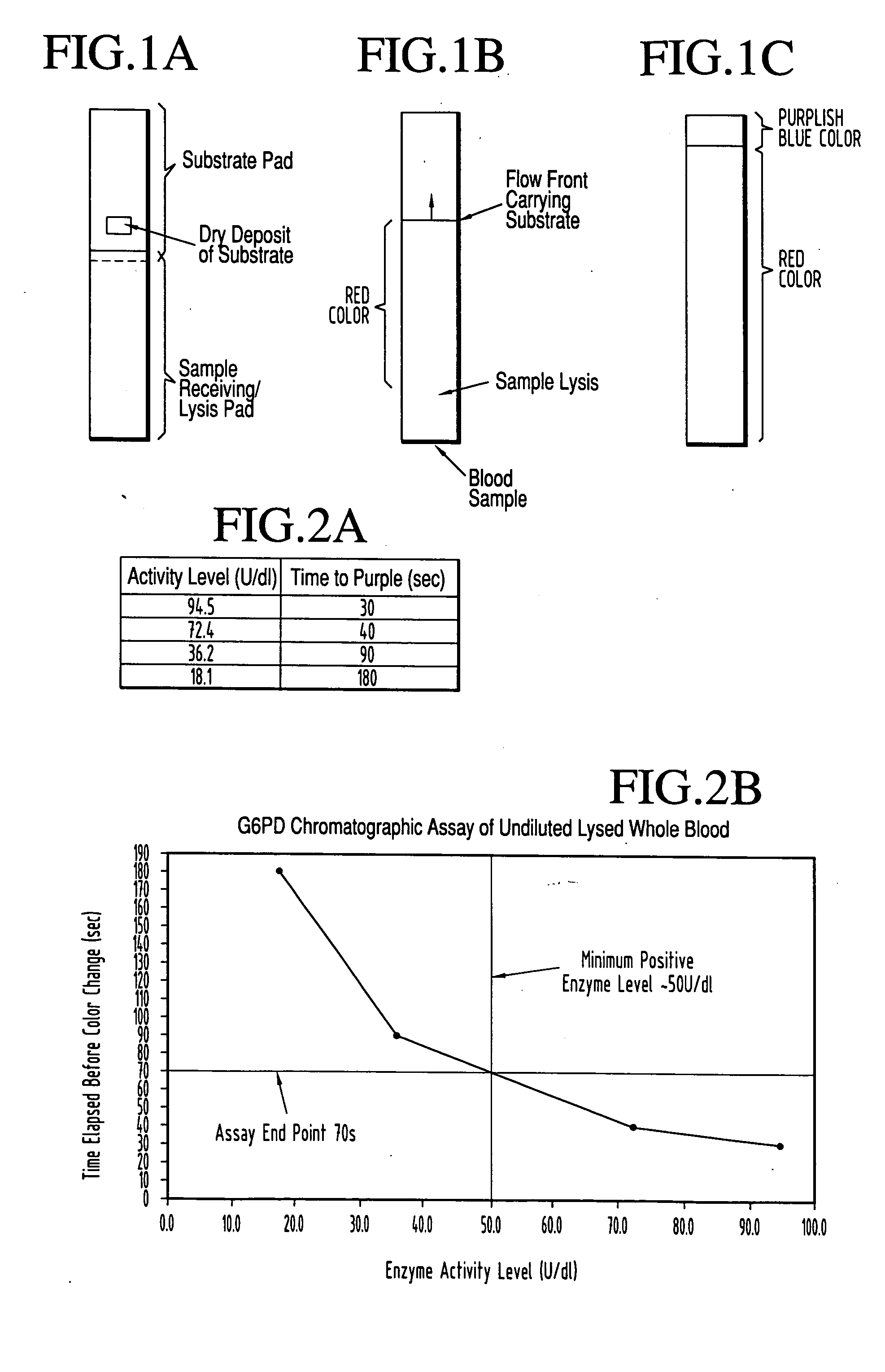Dry chemistry, lateral flow-reconstituted chromatographic enzyme-driven assays
a technology of chromatographic enzymes and enzymes, applied in the field of dry chemistry and lateral flowreconstituted chromatographic enzyme-driven assays, can solve the problems of reducing the efficiency of enzymes in biochemistry, ineffective in normal human biochemistry, and especially susceptible to oxidative attack
- Summary
- Abstract
- Description
- Claims
- Application Information
AI Technical Summary
Benefits of technology
Problems solved by technology
Method used
Image
Examples
example 1
[0066] This test is performed on a lateral flow strip as pictured in FIG. 1A, having a `lyse"or, wicking, pad from which the sample flows forward into the second, or substrate pad. The latter pad has two regions. The first such region is a tightly confined substrate zone in which is movably pre-deposited all of the dried components that may be conventionally used in the art to enable G6PD in the sample to reduce the faint yellow dye nitroblue tetrazolium, to dark blue formazan. The rate of conversion of nitroblue tetrazolium to dark blue formazan is one of several "wet chemistry" tests that has been used in the art to measure G6PD specific activity. The substrate pad also contains what is initially a substrate-free zone, positioned at the farthest end of the strip from the sample introduction point. As the sample picks up substrate and flows forward the initially substrate-free zone becomes the "read" or endpoint zone when the sample containing reconstituted substrate occupies it an...
example 2
[0074] As previously noted, the measurement of cholesterol concentration in a liquid sample can be performed by the enzyme-driven chromatographic assay of this invention in a manner similar to that for G6PD. A lateral flow test strip was constructed by depositing all of the reagents conventionally used in wet chemistry tests for total serum cholesterol plus a color-producing ingredient required to produce a color change at a rate proportional to the concentration of cholesterol constituents. The phenol derivative used in this experiment was TOOS i.e., 3-(N-ethyl-3-methylanilino)-2-hydroxypropane sulfonic acid (Sigma, E-8631) which produces a blue / purple color that can be readily distinguished above the hemoglobin background of a whole blood sample. A commercially available panel of serum cholesterol standards (Sigma, C-0534) was run on these test strips to confirm that the time to visualization was dependent on cholesterol concentration. A clear dose dependence was observed as seen ...
example 3
[0078] The beta-lactams are a class of antibiotics, including penicillins and cephalosporins, which contain a characteristic beta-lactam ring structure. This structure interferes with enzymes needed for the synthesis of peptidoglycan to produce defective cell walls in dividing bacteria and renders these walls susceptible to lysis by osmotic pressure. One mechanism of bacterial resistance to these antibiotics is the production of beta-lactamase enzymes, which specifically cleave the beta lactam ring, rendering the antibiotic ineffective and restoring the ability of the bacteria to multiply successfully.
[0079] A lateral flow enzyme-driven chromatographic test strip to detect the presence of .beta.-lactamase was constructed by depositing all of the reagents required according to prescribed prior art wet chemistry methodology, to produce a color change at a rate proportional to the concentration of .beta.-lactamase. As in Example 1, the liquid sample chromatographically reconstitutes th...
PUM
| Property | Measurement | Unit |
|---|---|---|
| Time | aaaaa | aaaaa |
| Angle | aaaaa | aaaaa |
| Temperature | aaaaa | aaaaa |
Abstract
Description
Claims
Application Information
 Login to View More
Login to View More - R&D
- Intellectual Property
- Life Sciences
- Materials
- Tech Scout
- Unparalleled Data Quality
- Higher Quality Content
- 60% Fewer Hallucinations
Browse by: Latest US Patents, China's latest patents, Technical Efficacy Thesaurus, Application Domain, Technology Topic, Popular Technical Reports.
© 2025 PatSnap. All rights reserved.Legal|Privacy policy|Modern Slavery Act Transparency Statement|Sitemap|About US| Contact US: help@patsnap.com



